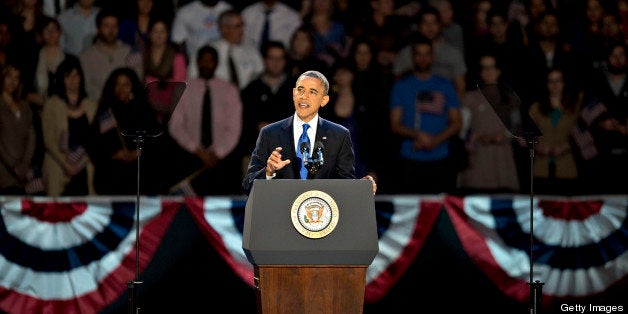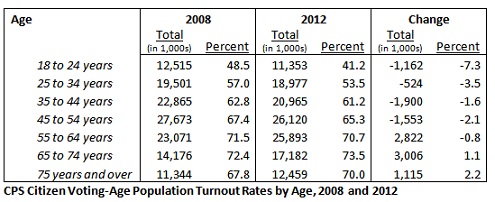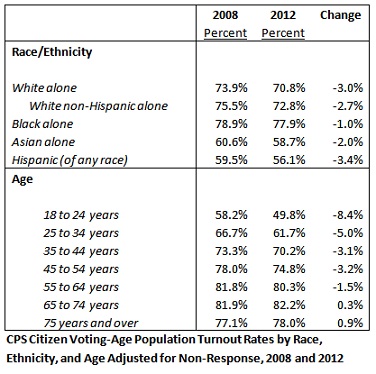
An important election survey that reveals patterns in voting and registration is the Census Bureau's Current Population Survey November Voting and Registration Supplement, or CPS for short. The 2012 CPS reveals insights to major stories about the election divined from the exit polls: the changing face of the electorate and the role of young people in determining the outcome of the presidential election. As I suggested previously, the increasing diversity of the 2012 electorate was a partially a turnout story, with non-Hispanic Whites modestly withdrawing from the electorate. The CPS further documents how it is also a story of the inevitable trend of increasing diversity of the country. Perhaps the most revealing new finding is a dramatic decrease in the youth vote, which has important ramifications for future elections.
The Changing Face of the Electorate
Among the major stories that emerged from the media's 2012 exit polls was how the non-White share of the electorate increased by two percentage points from 2008. The exit polls are, of course, only a survey of voters. The Census Bureau's CPS survey illuminates how turnout played a factor in the increasing non-White composition of the electorate, as suggestively evident in the aggregate election results.
According to the CPS, non-Hispanic White citizen voting-age population turnout rate decreased from 2008 to 2012 from 64.4% to 62.2%, or 2.2 percentage points. In raw terms, 1.3 million fewer non-Hispanic Whites voted in 2008 than 2012. While the country is becoming more ethnically diverse, non-Hispanic Whites are not experiencing a negative growth rate, rather other races and ethnicities are outpacing non-Hispanic White population growth. Comparatively, African-Americans experienced a small turnout rate increase -- although, I discuss below how this increase is an artifact of non-response bias. Even though the Hispanic turnout rate decreased 1.9 percentage points, 1.4 million more Hispanics voted in 2012 compared to 2008.
Thus, part of the changing face of the American electorate is a turnout rate story, with a small decline in non-Hispanic White turnout rates compared to other races. Part of it is also a true change in the composition of the country's citizenry, as the country becomes more diverse.
The Youth Drop Out
Republicans may feel encouraged for their future election prospects, in that fewer non-Hispanic Whites voted in 2012 than 2008, since Whites tend to vote Republican. However, in reality there is both good news and bad news for Democrats here, and an opportunity for Republicans.

The good news for Democrats is that the decline in non-Hispanic White turnout was primarily due to younger people abstaining. Turnout among all 18 to 24 year olds dropped 7.3 percentage points between 2008 and 2012. Indeed, this decline is evident across all races and ethnicities. Non-Hispanic White turnout among these youth dropped 7.4 percentage points; it dropped 6.7 percentage points for African-Americans; and it dropped 4.5 percentage points for Hispanics. Conversely, turnout rates increased for persons age 65 and older -- by 1.1 percentage points for persons age 65 to 74 and by 2.2 percentage points for persons age 75 and older -- a pattern that is again replicated among other racial and ethnic groups.
Lower youth turnout in 2012 is good news for Democrats from one perspective because Obama won in 2012 despite the withdrawal of this important Democratic constituency. Part of Obama's lower vote margin in 2012 compared to 2008 is due to lower youth turnout. However, there is certainly much for Democrats to be concerned about. Academic studies find that voting is habit-forming. Once a person has voted they are more likely to vote again, perhaps because they have learned how to navigate the system. The Obama campaign failed to mobilize the youth cohort who first became eligible to vote in the 2012 election, and Democrats will thus need to work harder in future elections to activate these people by registering them and helping them vote. These young people also present an opportunity for Republicans because they are the most persuadable potential voters, in that they have not yet become as fixed in their partisanship as people tend to do as they age. If Republicans can contact these young people first, they may be able to sway them to vote Republican.
Non-Response Bias: Did Black Turnout Really Exceed non-Hispanic White in 2012 for the First Time?
The short answer is that African-American turnout first exceeded non-Hispanic White turnout in 2008, not 2012. It did again in 2012.
The long-answer for polling nerds, involving non-response bias, follows.
The Census Bureau took a welcome step towards greater transparency in the 2012 Voting and Registration report regarding potential non-response bias -- or those who fail to participate in a poll or answer questions. Past Census Bureau practice has been to count persons who were not administered the voting and registration supplement, refused to answer a question, or did not know an answer as being a "no" response to questions such as if a person was registered or voted. While this practice continues in the 2012 report, for the first time the Census Bureau reports non-response in the detailed tables accompanying the report. While it has been possible to identify and remove non-responders using the raw individual-level data, the new practice enables more casual users of these data to make non-response adjustments.
Why does non-response matter? As I have discussed previously, non-response to the voting and registration supplement has been increasing over time and varies across important demographic groups -- such as race and ethnicity -- which can lead to erroneous conclusions when making temporal comparisons of registration and turnout rates. The good news is that the 2012 CPS non-response modestly declined from 2008 to 2012 -- from 13.8% in 2008 to 12.8% in 2012 -- reversing the upward trend.
The decline in non-response was mostly centered among African-Americans, of which 18.0% did not respond in 2008 compared with 15.0% in 2012. In comparison, non-Hispanic White non-response declined from 12.8% in 2008 to 12.2% in 2012.
The non-response has an important implication for a major finding reported on p.3 of the Census Bureau report:
Blacks voted at a higher rate (66.2 percent) than non-Hispanic Whites (64.1 percent) for the first time since the Census Bureau started publishing voting rates by the eligible citizenship population in 1996.
Keep in mind, the Census Bureau counts persons who did not respond to the survey as not-voting. I provide corrections to the tables presented above by removing those who did not provide a response t the voting question from the turnout rate calculations.

When non-respondents are removed from the turnout rate calculations, African-Americans first exceeded non-Hispanic White turnout in 2008 -- 78.9% to 75.5%. They did so again in 2012, 77.9% to 72.8%. Also of note is that African-American turnout rate is the only group to exhibit a turnout rate increase between 2008 and 2012 -- by 1.5 percentage points -- when counting non-respondents as having not voted, but decreased by 1.0 percentage points when non-respondents are removed. In the latter case, African-American turnout simply declined by a more modest amount than other races and ethnicities.
These adjusted numbers may help resolve another incongruity in the CPS survey data. The Census Bureau reports that the overall number of voters increased from 131.1 million in 2008 to 132.9 million. This can't possibly be correct since my tabulations from official election results show the overall turnout declined from 132.7 million to 130.7 million. The overall unadjusted turnout rate decreased by 1.8 percentage points while the adjusted turnout rate decreased 2.9 percentage points. The decline in the adjusted turnout rate is more in line with the decline observed among the administrative records, of 3.5 percentage points.
Summary
The big news from the CPS will be that African-American turnout exceeded non-Hispanic White turnout. But I contend that really that happened first in 2008. The more important political story may be the dramatic decline in youth turnout, as it poses a challenge to Democrats and an opportunity for Republicans. There is much more that will follow in the coming days -- from voter registration to early voting -- so stay tuned!